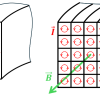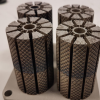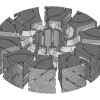Structured magnetic circuit for highly efficient electromagnetic machines
Technology description
| The name of the technology: | Structured magnetic circuit for highly efficient electromagnetic machines |
|---|---|
| Challenge: | The technology of 3D printing magnetic circuits is undergoing a dynamic development and offers enormous potential. 3D printing of steel alloys materials has brought revolutionary possibilities to the design of magnetic circuits in electrical machines, enabling a significant qualitative leap in the parameters of electric motors, actuators, and other electromagnetic machines. This approach enables the achievement of combination of high torque/force, low weight and high efficiency that are unattainable through conventional technologies, such as assembling magnetic circuits from laminated sheets. Due to its promising and attractive properties, this technology may become a key player in the electric motors or electromagnetic actuators market. Potential of this technology is further demonstrated by the fact that world leading institutes, e. g. NASA, Massachusetts Institute of Technology (MIT), Oak Ridge National Laboratory, Ghent University, University of Nottingham, and others. |
| Description: |
The 3D printing technology of magnetically conductive materials allows the shape of the magnetic circuit to be changed so that, with the same outer dimensions of the electromagnetic machine, higher magnetic fluxes can be achieved while reducing weight, reducing eddy losses and improving mechanical strength. As a result, more efficient electric motors/actuators can be designed with higher efficiency than can be produced by conventional folded sheet technology. The basic principle is to design the magnetic circuit in the form of a structure of rods that follow the direction of magnetic field lines in a magnetic core of solid material in steady state. These bars are isolated from each other, which prevents eddy currents (causing machine heating and therefore losses). The production of such shaped bodies was only made possible with the advent of 3D metal printing. It was not possible to produce a magnetic circuit from rod structures using conventional technologies. A European patent for this technology was granted to the team at the BUT in 2022. The principle can be well explained using an illustration of a cross-section of a toroidal magnetic circuit. With a rapid change in magnetic flux (green line, B) in the magnetic circuit, electromotive voltage is induced, which causes the formation of so-called eddy currents (red color, I). The orientation of the eddy currents is perpendicular to the direction of the magnetic flux. By dividing the magnetic circuit into small sections, mutually isolated rods, the eddy currents are generated into these small rods and their value is significantly lower. As a result, undesirable thermal losses in the magnetic circuit are avoided. In simple terms, this is an extension and improvement of the technology of laminating magnetic circuits. Thanks to 3D metal printing technology, these rods can be shaped with different cross-sections, shapes, or orientations to achieve the desired properties. Proper shaping can lead to weight savings, increased efficiency, or improved cooling. For example, minimizing eddy current losses is achievable by producing the magnetic circuit from the smallest rods possible, down to the manufacturing limits of 3D printing technology. The rods can be as small as a few tenths of a millimeter. The geometry of the circuit can be optimized for the best possible cooling, and cooling channels can be integrated within the magnetic circuit, for instance. This technology also offers a tremendous opportunity to use materials that are very difficult to process with lamination technology, such as Fe-Si alloys with high silicon content, among others. |
| Commercial opportunity: |
The technology allows to achieve a superior combination of parameters torque/force, weight, efficiency, power, which cannot be achieved by conventional technology of folding magnetic circuits from laminated sheets. Given the higher cost of 3D printing production today, it makes sense to use this technology especially in high-tech areas such as aero-space, where even a small increase in specific power or efficiency leads to a multiplier effect with a substantial increase in range with less fuel consumption. Manufacturers of electric motors for ultralight aircraft and heavy drones in particular are currently interested in this technology. In the future, the price of 3D metal printing can be expected to fall, allowing the technology to penetrate into less demanding applications. Given that approximately 45% of all electricity produced is consumed by electric motors, the transition to electric motors with higher efficiency structured magnetic circuits has the potential to reduce electricity consumption on a global scale. |
| IP protection status: | Patent EP337331 has been granted for this technology. |
| Development status: |
Phase 2Corresponds with TRL 3 and TRL 4 Feasibility study. There is a realistic design of the technology and the initial tests in the laboratory are leading to the specification of the technology requirements and its capabilities.
|
| Partnering strategy: | Collaboration investment licensing |
| More information: | |
| Images: | |
| Categories: | Engineering |
| Institution: | Brno University of Technology |
| Owner of a technology: | Vysoké učení technické v Brně |


